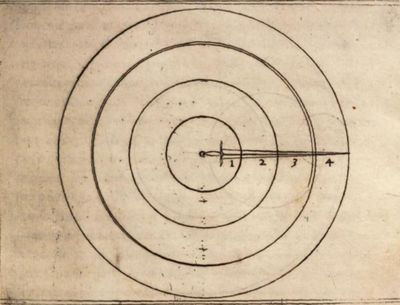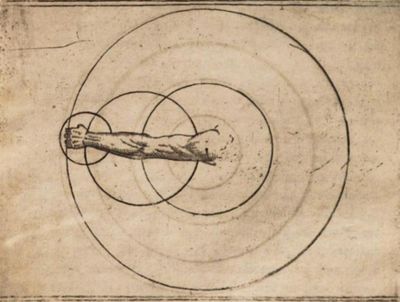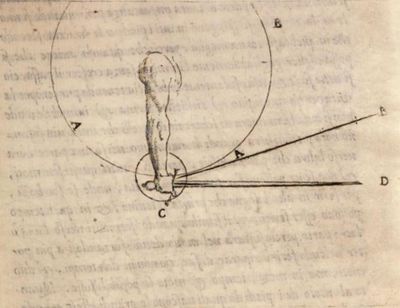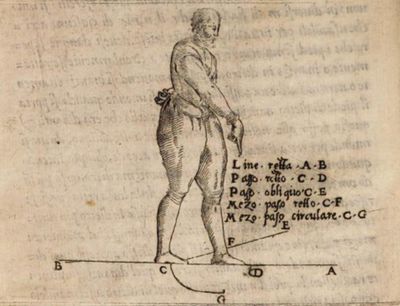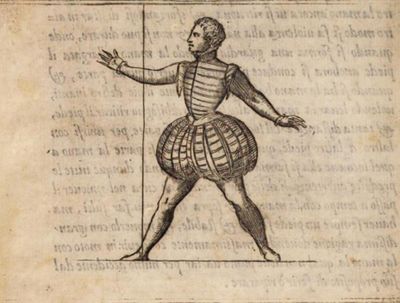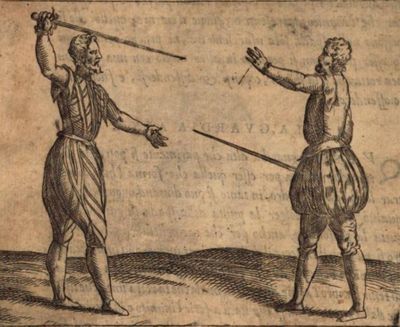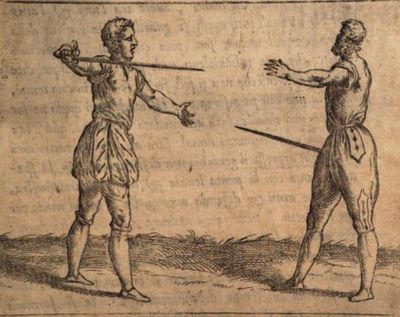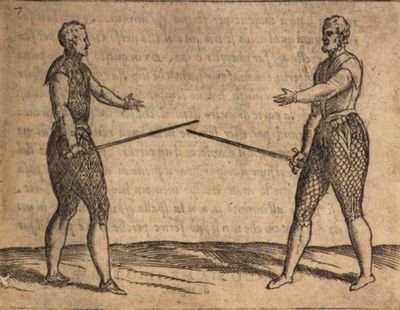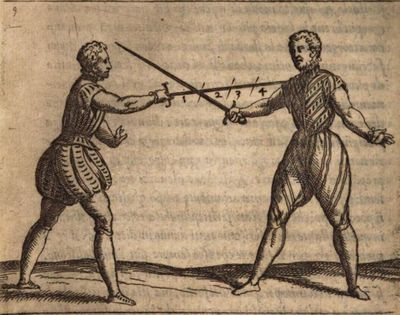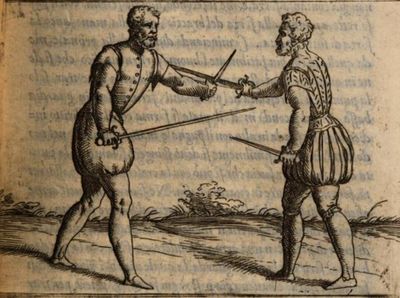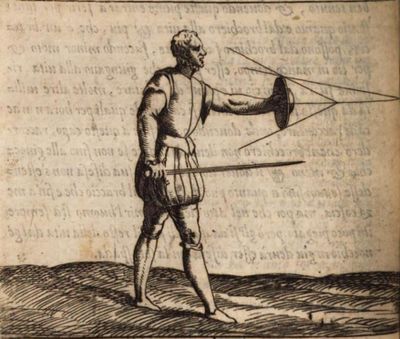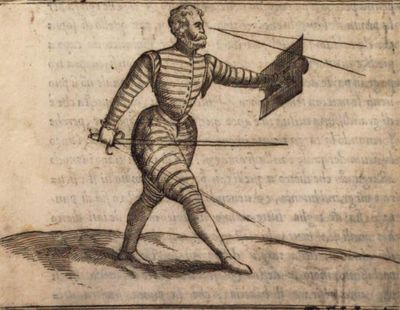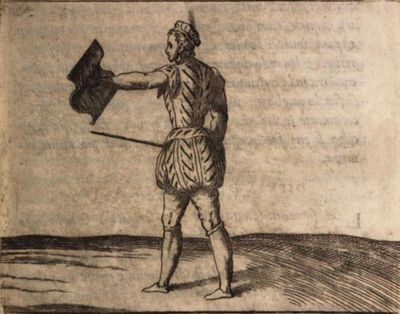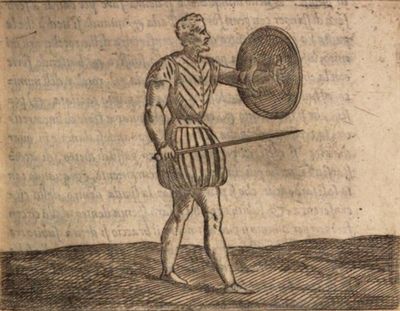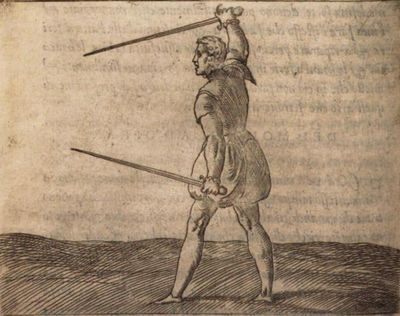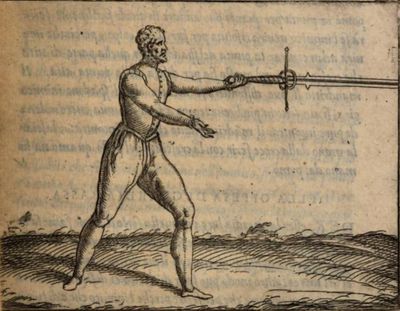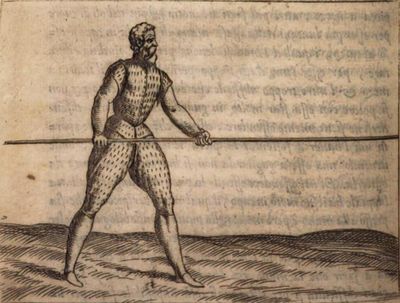|
|
You are not currently logged in. Are you accessing the unsecure (http) portal? Click here to switch to the secure portal. |
Difference between revisions of "Giacomo di Grassi"
(→Temp) |
(→Temp) |
||
| Line 2,271: | Line 2,271: | ||
{{master end}} | {{master end}} | ||
| − | |||
{{master begin | {{master begin | ||
| − | | title = Deceits and Falsings | + | | title = Deceits and Falsings (all weapons again) |
| width = 120em | | width = 120em | ||
}} | }} | ||
| Line 2,285: | Line 2,284: | ||
|- | |- | ||
| | | | ||
| − | | '''The | + | | <p>'''The second part entreating of deceits and falsings of blows and thrusts'''</p> |
| − | Being come to the end of the true Art, and having | + | | {{section|Page:Ragione di adoprar sicuramente l'Arme (Giacomo di Grassi) 1570.pdf/145|1|lbl=119}} |
| + | | {{section|Page:DiGraſsi his true Arte of Defence (Giacomo di Grassi) 1594.pdf/145|1|lbl=133}} | ||
| + | |||
| + | |- | ||
| + | | | ||
| + | | <p>Being come to the end of the true Art, and having declared all which seemed convenient and profitable for the attainment of true judgment in the handling of the weapon & of the entire knowledge of all advantages, by the which as well all disadvantages are known: It shall be good that I entreat of Deceit or Falsing, as well to perform my promise, as also to satisfy those who are greatly delighted to skirmish, not with the pretense to hurt or overcome, but rather for their exercise and pastime:</p> | ||
| | | | ||
| − | | | + | | {{section|Page:DiGraſsi his true Arte of Defence (Giacomo di Grassi) 1594.pdf/145|2|lbl=-}} |
| − | |||
|- | |- | ||
| | | | ||
| − | | In which it is a brave and gallant thing and worthy of commendations to be skillful in the apt managing of the body, feet and hands, in moving nimbly sometimes with the hand, sometimes with the elbow, and sometimes with the shoulder, in retiring, in increasing, in lifting the body high, in bearing it low in one instant: in brief, delivering swiftly blows as well of the edge as of the point, both right and reversed, nothing regarding either time, advantage or measure, bestowin them at random every way. | + | | <p>In which it is a brave and gallant thing and worthy of commendations to be skillful in the apt managing of the body, feet and hands, in moving nimbly sometimes with the hand, sometimes with the elbow, and sometimes with the shoulder, in retiring, in increasing, in lifting the body high, in bearing it low in one instant: in brief, delivering swiftly blows as well of the edge as of the point, both right and reversed, nothing regarding either time, advantage or measure, bestowin them at random every way.</p> |
| | | | ||
| − | | | + | | {{section|Page:DiGraſsi his true Arte of Defence (Giacomo di Grassi) 1594.pdf/145|3|lbl=-}} |
|- | |- | ||
| | | | ||
| − | | But diverse men being blinded in their own conceits, do in these actions certainly believe that they are either more nimble, either more wary & discreet then their adversary is: of which their foolish opinion they are beastly proud and arrogant: | + | | <p>But diverse men being blinded in their own conceits, do in these actions certainly believe that they are either more nimble, either more wary & discreet then their adversary is: of which their foolish opinion they are beastly proud and arrogant:</p> |
| | | | ||
| − | | | + | | |
| + | {{section|Page:DiGraſsi his true Arte of Defence (Giacomo di Grassi) 1594.pdf/145|4|lbl=-|p=1}} {{section|Page:DiGraſsi his true Arte of Defence (Giacomo di Grassi) 1594.pdf/146|1|lbl=134|p=1}} | ||
|- | |- | ||
| | | | ||
| − | | And because it has many times happened them, either with a false thrust, or edge blow, to hurt or abuse the enemy, they become lofty, and presume thereon as though their blows were not to be warded. But yet for the most part it falls out, that by a plain simple swab having only a good stomach and stout courage, they are chopped in with a thrust, and so miserably slain. | + | | <p>And because it has many times happened them, either with a false thrust, or edge blow, to hurt or abuse the enemy, they become lofty, and presume thereon as though their blows were not to be warded. But yet for the most part it falls out, that by a plain simple swab having only a good stomach and stout courage, they are chopped in with a thrust, and so miserably slain.</p> |
| | | | ||
| − | | | + | | {{section|Page:DiGraſsi his true Arte of Defence (Giacomo di Grassi) 1594.pdf/146|2|lbl=-}} |
|- | |- | ||
| | | | ||
| − | | For avoiding of this abuse, the best remedy is, that they exercise themselves in delivering these falses only in sport, and (as I have before said) for their practice and pastime: Resolving themselves for a truth, that when they are to deal with any enemy, & when it is upon danger of their lives, they must then suppose the enemy to be equal to themselves as well in knowledge as in strength, & accustom themselves to strike in as little time as is possible, and that always being well warded. And as for these Falses or Slips, they must use them for their exercises & pastimes sake only, and not presume upon them, except it beagainst such persons, who are either much more slow, either know not the true principals of this Art. For Deceit or Falsing is no other thing, then a blow or thrust delivered, not to the intent to hurt or hit home, but to cause the enemy to discover himself in some part, by means whereof a man may safely hurt him in the same part. And look how many blows or thrusts there may be given, so many falses or deceits may be used, and a great many more, which shall be declared in their proper place: The defense likewise whereof shall in few words be last of all laid upon you. | + | | <p>For avoiding of this abuse, the best remedy is, that they exercise themselves in delivering these falses only in sport, and (as I have before said) for their practice and pastime: Resolving themselves for a truth, that when they are to deal with any enemy, & when it is upon danger of their lives, they must then suppose the enemy to be equal to themselves as well in knowledge as in strength, & accustom themselves to strike in as little time as is possible, and that always being well warded. And as for these Falses or Slips, they must use them for their exercises & pastimes sake only, and not presume upon them, except it beagainst such persons, who are either much more slow, either know not the true principals of this Art. For Deceit or Falsing is no other thing, then a blow or thrust delivered, not to the intent to hurt or hit home, but to cause the enemy to discover himself in some part, by means whereof a man may safely hurt him in the same part. And look how many blows or thrusts there may be given, so many falses or deceits may be used, and a great many more, which shall be declared in their proper place: The defense likewise whereof shall in few words be last of all laid upon you.</p> |
| | | | ||
| − | | | + | | |
| + | {{section|Page:DiGraſsi his true Arte of Defence (Giacomo di Grassi) 1594.pdf/146|3|lbl=-|p=1}} {{section|Page:DiGraſsi his true Arte of Defence (Giacomo di Grassi) 1594.pdf/147|1|lbl=135|p=1}} | ||
|- | |- | ||
| | | | ||
| − | | ''' | + | | <p>'''Deceits or falsings of the single sword, or single rapier'''</p> |
| − | As I take not Victory to the end and scope of falsing, but rather nimbleness of body and dexterity in play: So, casting aside the consideration how a man is either covered or discovered, and how he has more or less advantage, I say that there may be framed at single sword so many wards, as there be ways to move the hand and foot. | + | |
| + | <p>As I take not Victory to the end and scope of falsing, but rather nimbleness of body and dexterity in play: So, casting aside the consideration how a man is either covered or discovered, and how he has more or less advantage, I say that there may be framed at single sword so many wards, as there be ways to move the hand and foot.</p> | ||
| | | | ||
| − | | | + | | {{section|Page:DiGraſsi his true Arte of Defence (Giacomo di Grassi) 1594.pdf/147|2|lbl=-}} |
| − | |||
|- | |- | ||
| | | | ||
| − | | Therefore in falsing there may be framed the high, low, and broad ward, with the right foot behind and before: a man may bear his sword with the point backwards and forwards: he may bear his right hand on the left side, with his sword's point backwards: he may stand at the low ward with the point backwards and forwards, bending towards the ground. And standing in all these ways, he may false a thrust above, and force it home beneath above, he may false it without and deliver it within, or contrariwise. | + | | <p>Therefore in falsing there may be framed the high, low, and broad ward, with the right foot behind and before: a man may bear his sword with the point backwards and forwards: he may bear his right hand on the left side, with his sword's point backwards: he may stand at the low ward with the point backwards and forwards, bending towards the ground. And standing in all these ways, he may false a thrust above, and force it home beneath above, he may false it without and deliver it within, or contrariwise.</p> |
| | | | ||
| − | | | + | | {{section|Page:DiGraſsi his true Arte of Defence (Giacomo di Grassi) 1594.pdf/147|3|lbl=-}} |
|- | |- | ||
| | | | ||
| − | | And according to the said manner of thrusting he may deliver edgeblows, right, reversed, high and low, as in that case shall most advantage him. Farther he may false an edgeblow, and deliver it home: as for example, to false a right blow on high, and deliver home a right and reverse blow, high or low. In like for the reverse is falsed, by delivering right or reverse blows, high or low. | + | | <p>And according to the said manner of thrusting he may deliver edgeblows, right, reversed, high and low, as in that case shall most advantage him. Farther he may false an edgeblow, and deliver it home: as for example, to false a right blow on high, and deliver home a right and reverse blow, high or low. In like for the reverse is falsed, by delivering right or reverse blows, high or low.</p> |
| | | | ||
| − | | | + | | {{section|Page:DiGraſsi his true Arte of Defence (Giacomo di Grassi) 1594.pdf/147|4|lbl=-}} |
|- | |- | ||
| | | | ||
| − | | But it is to be considered, that when he bears his sword with his point backwards, he false no other then the edgeblow, for then thrusts are discommodious. And because men do much use at this weapon, to beat off the point of the sword with their hands: therefore he must in that case for his greater readiness & advantage, suffer his sword to sway to that side, whether the enemy bears it, joining to that motion as much force as he may, performing therein a full circular blow, and delivering it at the enemy. | + | | <p>But it is to be considered, that when he bears his sword with his point backwards, he false no other then the edgeblow, for then thrusts are discommodious. And because men do much use at this weapon, to beat off the point of the sword with their hands: therefore he must in that case for his greater readiness & advantage, suffer his sword to sway to that side, whether the enemy bears it, joining to that motion as much force as he may, performing therein a full circular blow, and delivering it at the enemy.</p> |
| | | | ||
| − | | | + | | {{section|Page:DiGraſsi his true Arte of Defence (Giacomo di Grassi) 1594.pdf/148|1|lbl=136}} |
|- | |- | ||
| | | | ||
| − | | And this blow is most ready, and so much the rather, it is possible to be performed, by how much the enemy thinks not, that the sword will passe in full circle that way, for the enemy being somewhat disappointed, by beating off the sword, after which beating, he is also to deliver his thrust, he cannot so speedily speed both those times but that he shall be first struck with the edge of the sword, which he had before so beaten off. | + | | <p>And this blow is most ready, and so much the rather, it is possible to be performed, by how much the enemy thinks not, that the sword will passe in full circle that way, for the enemy being somewhat disappointed, by beating off the sword, after which beating, he is also to deliver his thrust, he cannot so speedily speed both those times but that he shall be first struck with the edge of the sword, which he had before so beaten off.</p> |
| | | | ||
| − | | | + | | {{section|Page:DiGraſsi his true Arte of Defence (Giacomo di Grassi) 1594.pdf/148|2|lbl=-}} |
|- | |- | ||
| | | | ||
| − | | ''' | + | | <p>'''General advertisements concerning the defenses''' |
| − | Because it chances commonly, that in managing of the hands, men bear no great regard, either to time or advantage, but do endeavor themselves after diverse & sundry ways & means to encounter the enemy's sword: therefore in these cases, it is very profitable to know how to strike, and what may be done in the shortest time. | + | |
| + | <p>Because it chances commonly, that in managing of the hands, men bear no great regard, either to time or advantage, but do endeavor themselves after diverse & sundry ways & means to encounter the enemy's sword: therefore in these cases, it is very profitable to know how to strike, and what may be done in the shortest time.</p> | ||
| | | | ||
| − | | | + | | {{section|Page:DiGraſsi his true Arte of Defence (Giacomo di Grassi) 1594.pdf/148|3|lbl=-}} |
| − | |||
|- | |- | ||
| | | | ||
| − | | The enemy's sword is encountered always either above, either in the middle, either beneath: & in all these ways a man finds himself to stand either above, either beneath, either within, either without. And it falls out always that men find themselvesunderneath with the sword at the hanging ward, when they are to ward high edgeblows or thrusts: and this way is most commonly used: The manner whereof is, when the hand is lifted up to defend the sword being thwarted, and the point turned downwards: when one finds himself so placed, he ought not to recover his sword from underneath, and then to deliver an edgeblow, for that were too long, but rather to strike nimbly that part of the enemy underneath, which is not warded, so that he shall do no other then turn his hand & deliver an edgeblow at the legs which surely speeds. | + | | <p>The enemy's sword is encountered always either above, either in the middle, either beneath: & in all these ways a man finds himself to stand either above, either beneath, either within, either without. And it falls out always that men find themselvesunderneath with the sword at the hanging ward, when they are to ward high edgeblows or thrusts: and this way is most commonly used: The manner whereof is, when the hand is lifted up to defend the sword being thwarted, and the point turned downwards: when one finds himself so placed, he ought not to recover his sword from underneath, and then to deliver an edgeblow, for that were too long, but rather to strike nimbly that part of the enemy underneath, which is not warded, so that he shall do no other then turn his hand & deliver an edgeblow at the legs which surely speeds.</p> |
| | | | ||
| − | | | + | | |
| + | {{section|Page:DiGraſsi his true Arte of Defence (Giacomo di Grassi) 1594.pdf/148|4|lbl=-|p=1}} {{section|Page:DiGraſsi his true Arte of Defence (Giacomo di Grassi) 1594.pdf/149|1|lbl=137|p=1}} | ||
|- | |- | ||
| | | | ||
| − | | But if he find himself in defense either of the reverse or thrust, to bear his sword aloft and without, and not hanging, in this the safest thing is, to increase a pace, and to seize upon the enemy's hand or arm. | + | | <p>But if he find himself in defense either of the reverse or thrust, to bear his sword aloft and without, and not hanging, in this the safest thing is, to increase a pace, and to seize upon the enemy's hand or arm.</p> |
| | | | ||
| − | | | + | | {{section|Page:DiGraſsi his true Arte of Defence (Giacomo di Grassi) 1594.pdf/149|2|lbl=-}} |
|- | |- | ||
| | | | ||
| − | | The self same he ought to do, finding himself in the middle, without and underneath: But if he find himself within, he cannot by any means make any seizure, because he shall then be in great peril to invest himself on the point of the enemy's sword. | + | | <p>The self same he ought to do, finding himself in the middle, without and underneath: But if he find himself within, he cannot by any means make any seizure, because he shall then be in great peril to invest himself on the point of the enemy's sword.</p> |
| | | | ||
| − | | | + | | {{section|Page:DiGraſsi his true Arte of Defence (Giacomo di Grassi) 1594.pdf/149|3|lbl=-}} |
|- | |- | ||
| | | | ||
| − | | Therefore to avoid the said point or thrust, he must turn his fist and deliver an edgeblow at the face, and withdraw himself by voiding of his foot towards the broad ward. And if he find himself beneath, & have encountered the enemy's edgeblow, either with the edge, or with the false or back of the sword, being beneath: then without any more ado, he ought to cut the legs, and void himself from the enemy's thrust. And let this be taken for a general rule: the body must be borne as far off from the enemy as it may. And blows always are to be delivered on that part which is found to be most near, be the stroke great or little. And each man is to be advertised that when he finds the enemy's weapon underneath at the hanging ward, he may safely make a seizure: but it would be done nimbly and with good courage, because he does then increase towards his enemy in the straight line, that is to say, increase on pace, and therewithall take holdfast of the enemy's sword, near the hilts thereof, yea though his hand were naked, and under his own sword presently turning his hand outwards, which of force wrests the sword out of the enemy's hand: neither ought he to fear to make seizure with his naked hand, for it is in such a place, that if should with his hand encounter a blow, happily it would not cut because the weapon has there very small force. All the hazard will be, if the enemy should draw back his sword, which causes it to cut. For in such sort it will cut mightily: but he may not give leisure or time to the enemy to draw back, but as soon as the seizure is made, he must also turn his hand outwards: in which case, the enemy has no force at all. | + | | <p>Therefore to avoid the said point or thrust, he must turn his fist and deliver an edgeblow at the face, and withdraw himself by voiding of his foot towards the broad ward. And if he find himself beneath, & have encountered the enemy's edgeblow, either with the edge, or with the false or back of the sword, being beneath: then without any more ado, he ought to cut the legs, and void himself from the enemy's thrust. And let this be taken for a general rule: the body must be borne as far off from the enemy as it may. And blows always are to be delivered on that part which is found to be most near, be the stroke great or little. And each man is to be advertised that when he finds the enemy's weapon underneath at the hanging ward, he may safely make a seizure: but it would be done nimbly and with good courage, because he does then increase towards his enemy in the straight line, that is to say, increase on pace, and therewithall take holdfast of the enemy's sword, near the hilts thereof, yea though his hand were naked, and under his own sword presently turning his hand outwards, which of force wrests the sword out of the enemy's hand: neither ought he to fear to make seizure with his naked hand, for it is in such a place, that if should with his hand encounter a blow, happily it would not cut because the weapon has there very small force. All the hazard will be, if the enemy should draw back his sword, which causes it to cut. For in such sort it will cut mightily: but he may not give leisure or time to the enemy to draw back, but as soon as the seizure is made, he must also turn his hand outwards: in which case, the enemy has no force at all.</p> |
| | | | ||
| − | | | + | | |
| + | {{section|Page:DiGraſsi his true Arte of Defence (Giacomo di Grassi) 1594.pdf/149|4|lbl=-|p=1}} {{section|Page:DiGraſsi his true Arte of Defence (Giacomo di Grassi) 1594.pdf/150|1|lbl=138|p=1}} | ||
|- | |- | ||
| | | | ||
| − | | These manner of strikings ought and may be practiced at all other weapons. Therefore this rule ought generally to be observed, and that is, to bear the body different from the enemy's sword, and to strike little or much, in small time as is possible. | + | | <p>These manner of strikings ought and may be practiced at all other weapons. Therefore this rule ought generally to be observed, and that is, to bear the body different from the enemy's sword, and to strike little or much, in small time as is possible.</p> |
| | | | ||
| − | | | + | | {{section|Page:DiGraſsi his true Arte of Defence (Giacomo di Grassi) 1594.pdf/150|2|lbl=-}} |
|- | |- | ||
| | | | ||
| − | | And if one would in delivering of a great edgeblow, use small motion and spend little time he ought as soon as he has struck, to draw or slide his sword, thereby causing it to cut: for otherwise an edgeblow is to no purpose, although it be very forcibly delivered, especially when it lights on any soft or limber thing: but being drawn, it does every way cut greatly. | + | | <p>And if one would in delivering of a great edgeblow, use small motion and spend little time he ought as soon as he has struck, to draw or slide his sword, thereby causing it to cut: for otherwise an edgeblow is to no purpose, although it be very forcibly delivered, especially when it lights on any soft or limber thing: but being drawn, it does every way cut greatly.</p> |
| + | | | ||
| | | | ||
| − | | | + | {{section|Page:DiGraſsi his true Arte of Defence (Giacomo di Grassi) 1594.pdf/150|3|lbl=-|p=1}} {{section|Page:DiGraſsi his true Arte of Defence (Giacomo di Grassi) 1594.pdf/151|1|lbl=139|p=1}} |
|- | |- | ||
| | | | ||
| − | | ''' | + | | <p>'''Of sword and dagger, or rapier and dagger'''</p> |
| − | All the wards which are laid down for the single sword, may likewise be given for the sword and dagger. And there is greater reason why they should be termed wards in the handling of this, than of the single sword, because albeit the sword is borne unorderly, & with such disadvantage, that it wards in a manner no part of the body, yet there is a dagger which continually stands at his defense, in which case, it is not convenient that a man lift up both his arms and leave his body open to the enemy: for it is neither agreeable to true, neither to false art considering that in each of them the endeavor is to overcome. And this manner of lifting up the arms, is as if a man would of purpose be overcome: Therefore, when in this deceitful and false art, one is to use two weapons, he must take heed that he bear the one continually at his defense, and to handle the other every way to molest the enemy: sometime framing one ward, sometimes an other: and in each of them to false, that is, to feign a thrust, and deliver a thrust, to false a thrust, and give an edgeblow: and otherwise also, to false an edgeblow, and to deliver an edgeblow. And in all these ways to remember, that the blow be continually different from the false: That is, if the thrust be falsed above to drive it home below: If within, yet to strike without, and falsing an edgeblow above, to bestow it beneath: or falsing a right blow, to strike with the reverse: or sometimes with a right blow, but yet differing from the other. And after an edgeblow on high, to deliver a reverse below. In fine, to make all such mixture of blows, as may bear all these contrarieties following, to wit, the point, the edge, high, low, right, reversed, within, without. But, I see not how one may practice any deceit with the dagger, the which is not openly dangerous. As for example, to widen it and discover some part of the body to the enemy, thereby provoking him to move, and then warding, to strike him, being so disappointed: but in my opinion, these sorts of falses of discovering the body, ought not to be used: For it behooves a man, first, safely defend to himself, and then to offend the enemy, the which he cannot do, in the practice of the said falses, if he chance to deal with an enemy that is courageous and skillful. But this manner of falsing next following, is to be practiced last of all other, and as it were in desperate cases. And it is, either to feign, as though he would forcibly fling his dagger at the enemy's face, (from the which false, he shall doubtless procure the enemy to ward himself, either by lifting up the arms, or by retiring himself, or by moving towards one side of other, in which travail & time, a man that is very wary and nimble, may safely hurt him) or else instead of falsing a blow, to fling the dagger indeed at the enemy's face. In which chance or occasion, it is necessary that he have the skill how to stick the dagger with the point. But yet howsoever it chance, the coming of the dagger in such sort, does so greatly trouble and disorder the enemy, that if a man step in nimbly, he may safely hurt him. | + | |
| + | <p>All the wards which are laid down for the single sword, may likewise be given for the sword and dagger. And there is greater reason why they should be termed wards in the handling of this, than of the single sword, because albeit the sword is borne unorderly, & with such disadvantage, that it wards in a manner no part of the body, yet there is a dagger which continually stands at his defense, in which case, it is not convenient that a man lift up both his arms and leave his body open to the enemy: for it is neither agreeable to true, neither to false art considering that in each of them the endeavor is to overcome. And this manner of lifting up the arms, is as if a man would of purpose be overcome: Therefore, when in this deceitful and false art, one is to use two weapons, he must take heed that he bear the one continually at his defense, and to handle the other every way to molest the enemy: sometime framing one ward, sometimes an other: and in each of them to false, that is, to feign a thrust, and deliver a thrust, to false a thrust, and give an edgeblow: and otherwise also, to false an edgeblow, and to deliver an edgeblow. And in all these ways to remember, that the blow be continually different from the false: That is, if the thrust be falsed above to drive it home below: If within, yet to strike without, and falsing an edgeblow above, to bestow it beneath: or falsing a right blow, to strike with the reverse: or sometimes with a right blow, but yet differing from the other. And after an edgeblow on high, to deliver a reverse below. In fine, to make all such mixture of blows, as may bear all these contrarieties following, to wit, the point, the edge, high, low, right, reversed, within, without. But, I see not how one may practice any deceit with the dagger, the which is not openly dangerous. As for example, to widen it and discover some part of the body to the enemy, thereby provoking him to move, and then warding, to strike him, being so disappointed: but in my opinion, these sorts of falses of discovering the body, ought not to be used: For it behooves a man, first, safely defend to himself, and then to offend the enemy, the which he cannot do, in the practice of the said falses, if he chance to deal with an enemy that is courageous and skillful. But this manner of falsing next following, is to be practiced last of all other, and as it were in desperate cases. And it is, either to feign, as though he would forcibly fling his dagger at the enemy's face, (from the which false, he shall doubtless procure the enemy to ward himself, either by lifting up the arms, or by retiring himself, or by moving towards one side of other, in which travail & time, a man that is very wary and nimble, may safely hurt him) or else instead of falsing a blow, to fling the dagger indeed at the enemy's face. In which chance or occasion, it is necessary that he have the skill how to stick the dagger with the point. But yet howsoever it chance, the coming of the dagger in such sort, does so greatly trouble and disorder the enemy, that if a man step in nimbly, he may safely hurt him.</p> | ||
| + | | | ||
| | | | ||
| − | | | + | {{section|Page:DiGraſsi his true Arte of Defence (Giacomo di Grassi) 1594.pdf/151|2|lbl=-|p=1}} {{section|Page:DiGraſsi his true Arte of Defence (Giacomo di Grassi) 1594.pdf/152|1|lbl=140|p=1}} {{section|Page:DiGraſsi his true Arte of Defence (Giacomo di Grassi) 1594.pdf/153|1|lbl=141|p=1}} |
| − | |||
|- | |- | ||
| | | | ||
| − | | These deceits and falses, of the sword and dagger, may be warded according as a man finds it most commodious either with the sword, or else with the dagger, not regarding at all (as in true art) to defend the left side with the dagger, and the right side with the sword: For in this false art men consider not either of advantage, time, or measure, but always their manner is (as soon as they have found the enemy's sword) to strike by the most short way, be it either with the edge, or point, notwithstanding the blow be not forcible, but only touch weakly & scarcely: for in play, so it touch any way, it is accounted for victory. | + | | <p>These deceits and falses, of the sword and dagger, may be warded according as a man finds it most commodious either with the sword, or else with the dagger, not regarding at all (as in true art) to defend the left side with the dagger, and the right side with the sword: For in this false art men consider not either of advantage, time, or measure, but always their manner is (as soon as they have found the enemy's sword) to strike by the most short way, be it either with the edge, or point, notwithstanding the blow be not forcible, but only touch weakly & scarcely: for in play, so it touch any way, it is accounted for victory.</p> |
| | | | ||
| − | | | + | | {{section|Page:DiGraſsi his true Arte of Defence (Giacomo di Grassi) 1594.pdf/153|2|lbl=-|p=1}} |
|- | |- | ||
| | | | ||
| − | | Concerning taking holdfast, or seizing the enemy's sword, I commend not in any case, that seizure be made with the left hand, by casting a way of the dagger, as else I have seen it practiced: but rather that it be done keeping the sword and dagger fast in hand. And although this seem impossible, yet every one that is nimble & strong of arm, may safely do it. And this seizure is used as well under an edgeblow, as under a thrust in the manner following. | + | | <p>Concerning taking holdfast, or seizing the enemy's sword, I commend not in any case, that seizure be made with the left hand, by casting a way of the dagger, as else I have seen it practiced: but rather that it be done keeping the sword and dagger fast in hand. And although this seem impossible, yet every one that is nimble & strong of arm, may safely do it. And this seizure is used as well under an edgeblow, as under a thrust in the manner following.</p> |
| | | | ||
| − | | | + | | {{section|Page:DiGraſsi his true Arte of Defence (Giacomo di Grassi) 1594.pdf/153|3|lbl=-}} |
|- | |- | ||
| | | | ||
| − | | When an edgeblow or thrust comes above, it must be encountered with the sword without, on the third or fourth part of the enemy's sword, and with the dagger born within, on the first or second part thereof: having thus suddenly taken the enemy's sword in the middle, to turn forcibly the enemy's sword outwards with the dagger, keeping the sword steadfast, and as straight towards the enemy as possible by means whereof it may the more easily be turned. And there is no doubt but the enemy's sword may be wrung out of his hand, and look how much nearer the point it is taken, so much the more easily it is turned or wrested outwards, because it makes the greater circle, and the enemy has but small force to resist that motion. | + | | <p>When an edgeblow or thrust comes above, it must be encountered with the sword without, on the third or fourth part of the enemy's sword, and with the dagger born within, on the first or second part thereof: having thus suddenly taken the enemy's sword in the middle, to turn forcibly the enemy's sword outwards with the dagger, keeping the sword steadfast, and as straight towards the enemy as possible by means whereof it may the more easily be turned. And there is no doubt but the enemy's sword may be wrung out of his hand, and look how much nearer the point it is taken, so much the more easily it is turned or wrested outwards, because it makes the greater circle, and the enemy has but small force to resist that motion.</p> |
| | | | ||
| − | | | + | | |
| + | {{section|Page:DiGraſsi his true Arte of Defence (Giacomo di Grassi) 1594.pdf/153|4|lbl=-|p=1}} {{section|Page:DiGraſsi his true Arte of Defence (Giacomo di Grassi) 1594.pdf/154|1|lbl=142|p=1}} | ||
|- | |- | ||
| | | | ||
| − | | ''' | + | | <p>'''Of sword and cloak, or rapier and cloak'''</p> |
| − | For to deceive the enemy with the cloak, it is necessary to know how many ways it may serve the turn, and to be skillful how to fold it orderly about the arm, and how to take advantage by the largeness thereof: and farther to understand how to defend, and how to offend and hinder the enemy therewith, because it fails not always, that men fight with their cloak wrapped about the arm, and the sword in hand, Therefore it is the part of a wise man, to know also how to handle the cloak after any other manner. | + | |
| + | <p>For to deceive the enemy with the cloak, it is necessary to know how many ways it may serve the turn, and to be skillful how to fold it orderly about the arm, and how to take advantage by the largeness thereof: and farther to understand how to defend, and how to offend and hinder the enemy therewith, because it fails not always, that men fight with their cloak wrapped about the arm, and the sword in hand, Therefore it is the part of a wise man, to know also how to handle the cloak after any other manner.</p> | ||
| | | | ||
| − | | | + | | {{section|Page:DiGraſsi his true Arte of Defence (Giacomo di Grassi) 1594.pdf/154|2|lbl=-|p=1}} |
| − | |||
|- | |- | ||
| | | | ||
| − | | Wherefore one may get the advantage of the Cloak, both when it is about his body, and when it is folded about his arm: The Cloak eing about the arm in this manner. When it chances that any man to bicker with his enemy, with whom he is at point to join, but yet happily wears about him at that instant no kind of weapon, whereas his enemy is weaponed, & threatens him, then by taking both sides of the cloak as near the collar as is possible, he may draw if over his own head, and throw it at his enemy's face, who then being entangled and blinded there with, may either be thrown down, or disfurnished of his weapon very easily by him that is nimble, especially if he have to deal against one who is slow. A man may after another manner take the advantage of the cloak which the enemy wears, by taking with one hand both sides thereof, near the collar: which sides being strongly held, cause the cloak to be a gin being violently held, and plucked with one hand, he may so forcibly strike him with the other on the face or visage, that he will go near hand to break his neck. | + | | <p>Wherefore one may get the advantage of the Cloak, both when it is about his body, and when it is folded about his arm: The Cloak eing about the arm in this manner. When it chances that any man to bicker with his enemy, with whom he is at point to join, but yet happily wears about him at that instant no kind of weapon, whereas his enemy is weaponed, & threatens him, then by taking both sides of the cloak as near the collar as is possible, he may draw if over his own head, and throw it at his enemy's face, who then being entangled and blinded there with, may either be thrown down, or disfurnished of his weapon very easily by him that is nimble, especially if he have to deal against one who is slow. A man may after another manner take the advantage of the cloak which the enemy wears, by taking with one hand both sides thereof, near the collar: which sides being strongly held, cause the cloak to be a gin being violently held, and plucked with one hand, he may so forcibly strike him with the other on the face or visage, that he will go near hand to break his neck.</p> |
| | | | ||
| − | | | + | | |
| + | {{section|Page:DiGraſsi his true Arte of Defence (Giacomo di Grassi) 1594.pdf/154|3|lbl=-|p=1}} {{section|Page:DiGraſsi his true Arte of Defence (Giacomo di Grassi) 1594.pdf/155|1|lbl=143|p=1}} | ||
|- | |- | ||
| | | | ||
| − | | There be many other ways whereby one may prevail with the cloak, to the greatest part whereof, men of mean judgment may easily attain unto. Therefore when one has his cloak on his arm, and sword in his hand, the advantage he gets thereby, besides the warding of blows, for that has been declared in the true art is, that he may molest his enemy by falsing to fling his cloak, and then to fling it in deed. But to false the flinging of the cloak is very dangerous, because it may not be done but in long time. And the very flinging of the cloak, is as it were a preparation to get the victory, and is in a manner rather true art then deceit, considering it is done by the straight or some other short line: neither for any other cause is this the rather here laid down, in deceit, then before in true art, then for that when one overcomes by this means, he seems not to conquer manfully, because he strikes the enemy before blinded with the cloak. Therefore when one minds to fling his cloak, he may either do it from and with his arm, or else with his sword: in so doing it is necessary, that he have not the cloak too much wrapped about his arm: I say, not above twice, neither to hold it straight or fast with his hand, that thereby he may be the better able when occasion serves to fling it more easily. If therefore he would fling it with his arm, and have it go with such fury, and make such effect as is required, he must of force join to the flinging thereof the increase of a pace, on that side where the cloak is, but first of all he must encounter, either find, either so endure the enemy's sword, that by the means of the increase of that pace it may do no hurt. | + | | <p>There be many other ways whereby one may prevail with the cloak, to the greatest part whereof, men of mean judgment may easily attain unto. Therefore when one has his cloak on his arm, and sword in his hand, the advantage he gets thereby, besides the warding of blows, for that has been declared in the true art is, that he may molest his enemy by falsing to fling his cloak, and then to fling it in deed. But to false the flinging of the cloak is very dangerous, because it may not be done but in long time. And the very flinging of the cloak, is as it were a preparation to get the victory, and is in a manner rather true art then deceit, considering it is done by the straight or some other short line: neither for any other cause is this the rather here laid down, in deceit, then before in true art, then for that when one overcomes by this means, he seems not to conquer manfully, because he strikes the enemy before blinded with the cloak. Therefore when one minds to fling his cloak, he may either do it from and with his arm, or else with his sword: in so doing it is necessary, that he have not the cloak too much wrapped about his arm: I say, not above twice, neither to hold it straight or fast with his hand, that thereby he may be the better able when occasion serves to fling it more easily. If therefore he would fling it with his arm, and have it go with such fury, and make such effect as is required, he must of force join to the flinging thereof the increase of a pace, on that side where the cloak is, but first of all he must encounter, either find, either so endure the enemy's sword, that by the means of the increase of that pace it may do no hurt.</p> |
| + | | | ||
| | | | ||
| − | | | + | {{section|Page:DiGraſsi his true Arte of Defence (Giacomo di Grassi) 1594.pdf/155|2|lbl=-|p=1}} {{section|Page:DiGraſsi his true Arte of Defence (Giacomo di Grassi) 1594.pdf/156|1|lbl=144|p=1}} |
|- | |- | ||
| | | | ||
| − | | And it is requisite in every occasion, that he find himselfto stand without: and when either an edgeblow or a thrust comes, be it above or in the middle, as soon as he has warded it with his sword, he shall increase a pace and fling his cloak, howsoever it be folded, either from the collar, either from any other part, or else to hale it off from his shoulder, although it be on his shoulder: and in this order it is easily thrown, & is thereby the more widened in such sort, that the enemy is the more entangled and snared therewith. | + | | <p>And it is requisite in every occasion, that he find himselfto stand without: and when either an edgeblow or a thrust comes, be it above or in the middle, as soon as he has warded it with his sword, he shall increase a pace and fling his cloak, howsoever it be folded, either from the collar, either from any other part, or else to hale it off from his shoulder, although it be on his shoulder: and in this order it is easily thrown, & is thereby the more widened in such sort, that the enemy is the more entangled and snared therewith.</p> |
| | | | ||
| − | | | + | | {{section|Page:DiGraſsi his true Arte of Defence (Giacomo di Grassi) 1594.pdf/156|2|lbl=-}} |
|- | |- | ||
| | | | ||
| − | | Concerning the flinging of the cloak with the sword, I say, it may be thrown either with the point, either with the edge: with the point when one stands at the low ward with the right foot behind, and the cloak before: In which case the cloak that would be well and thick doubled and placed on the arm, but not wrapped. And instead of driving a thrust with the point which shall be hidden behind the cloak, he shall take the cloak on the point of the sword, and with the increase of a pace, force it at the enemy's face. And in this manner the cloak is so forcibly, and so covertly delivered and flung, that the enemy is neither aware of it, neither can avoid it, but of force it lights on his face, by means whereof, he may be struck at pleasure in any part of the body. | + | | <p>Concerning the flinging of the cloak with the sword, I say, it may be thrown either with the point, either with the edge: with the point when one stands at the low ward with the right foot behind, and the cloak before: In which case the cloak that would be well and thick doubled and placed on the arm, but not wrapped. And instead of driving a thrust with the point which shall be hidden behind the cloak, he shall take the cloak on the point of the sword, and with the increase of a pace, force it at the enemy's face. And in this manner the cloak is so forcibly, and so covertly delivered and flung, that the enemy is neither aware of it, neither can avoid it, but of force it lights on his face, by means whereof, he may be struck at pleasure in any part of the body.</p> |
| + | | | ||
| | | | ||
| − | | | + | {{section|Page:DiGraſsi his true Arte of Defence (Giacomo di Grassi) 1594.pdf/156|3|lbl=-|p=1}} {{section|Page:DiGraſsi his true Arte of Defence (Giacomo di Grassi) 1594.pdf/157|1|lbl=145|p=1}} |
|- | |- | ||
| | | | ||
| − | | The cloak may be flung or thrown with the edge of the sword, when one stands at the low ward, with the point of the sword turned backwards, one the left side and the cloak upon it, folded at large upon the arm up to the elbow: but not fast wrapped about it, and whilst he falses a reverse, he may take the cloak on the edge of the sword and fling it towards the enemy, and then strike him with such a blow as shall be then most fit for his advantage deliver. | + | | <p>The cloak may be flung or thrown with the edge of the sword, when one stands at the low ward, with the point of the sword turned backwards, one the left side and the cloak upon it, folded at large upon the arm up to the elbow: but not fast wrapped about it, and whilst he falses a reverse, he may take the cloak on the edge of the sword and fling it towards the enemy, and then strike him with such a blow as shall be then most fit for his advantage deliver.</p> |
| | | | ||
| − | | | + | | {{section|Page:DiGraſsi his true Arte of Defence (Giacomo di Grassi) 1594.pdf/157|2|lbl=-}} |
|- | |- | ||
| | | | ||
| − | | Many other deceits there may be declared of the cloak, as well of flinging as of falsing it: but because I think these to be sufficient for an example to frame many other by, I make an end. | + | | <p>Many other deceits there may be declared of the cloak, as well of flinging as of falsing it: but because I think these to be sufficient for an example to frame many other by, I make an end.</p> |
| | | | ||
| − | | | + | | {{section|Page:DiGraſsi his true Arte of Defence (Giacomo di Grassi) 1594.pdf/157|3|lbl=-}} |
|- | |- | ||
| | | | ||
| − | | ''' | + | | <p>'''Falsing of blows, of sword and buckler square target, and round target'''</p> |
| − | Being of the opinion that as touching deceit, there is but one consideration to be had of all these three weapons, and for because all the difference which may be between them is laid down and declared in the true art, in the consideration of form of each of them: Therefore I am willing rather to restrain myself, then to endeavor to fill the lease with the idle repetition of one thing twice. | + | |
| + | <p>Being of the opinion that as touching deceit, there is but one consideration to be had of all these three weapons, and for because all the difference which may be between them is laid down and declared in the true art, in the consideration of form of each of them: Therefore I am willing rather to restrain myself, then to endeavor to fill the lease with the idle repetition of one thing twice.</p> | ||
| | | | ||
| − | | | + | | {{section|Page:DiGraſsi his true Arte of Defence (Giacomo di Grassi) 1594.pdf/158|1|lbl=146}} |
| − | |||
|- | |- | ||
| | | | ||
| − | | All these three weapons ought to be borne in the fist, the arm stretched out forwards, and this is evidently seen in the square Target and buckler: the round Target also, because by reason of his greatness and weight, it may not be held in the only fist, & forward, in which kind of holding, it would ward much more is borne on the arm, being stretched forth with the fist forwards, which is in manner all one, or the self same. Therefore one may false as much with the one as with the other, considering there is no other false used with them then to discover and frame diverse wards, bearing no respect to any advantage. And yet there is this difference between them, that with the round Target, one may easily ward both edgeblows and thrusts, and with the square Target, better than with any other, he may ward edgeblows, because it is of square form: and the edge of the sword may easily be retained with the straight side thereof, which is not so easily done with the buckler: for over and besides the warding of thrusts, the buckler is not so sure of itself, but requires aid of the sword. Edgeblows also when they come a thwart (for in that case, they encounter the circumference thereof: the which if it chance, the sword not to encounter on the diameter, or half, in which place the sword is only stayed, but does encounter it, either beneath, either above the said diameter (may easily slip and strike either the head or thighs: therefore let every man take heed and remember, that in striking at the buckler, either with the point or edge of the sword, he deliver it crossing or a thwart. | + | | <p>All these three weapons ought to be borne in the fist, the arm stretched out forwards, and this is evidently seen in the square Target and buckler: the round Target also, because by reason of his greatness and weight, it may not be held in the only fist, & forward, in which kind of holding, it would ward much more is borne on the arm, being stretched forth with the fist forwards, which is in manner all one, or the self same. Therefore one may false as much with the one as with the other, considering there is no other false used with them then to discover and frame diverse wards, bearing no respect to any advantage. And yet there is this difference between them, that with the round Target, one may easily ward both edgeblows and thrusts, and with the square Target, better than with any other, he may ward edgeblows, because it is of square form: and the edge of the sword may easily be retained with the straight side thereof, which is not so easily done with the buckler: for over and besides the warding of thrusts, the buckler is not so sure of itself, but requires aid of the sword. Edgeblows also when they come a thwart (for in that case, they encounter the circumference thereof: the which if it chance, the sword not to encounter on the diameter, or half, in which place the sword is only stayed, but does encounter it, either beneath, either above the said diameter (may easily slip and strike either the head or thighs: therefore let every man take heed and remember, that in striking at the buckler, either with the point or edge of the sword, he deliver it crossing or a thwart.</p> |
| + | | | ||
| | | | ||
| − | | | + | {{section|Page:DiGraſsi his true Arte of Defence (Giacomo di Grassi) 1594.pdf/158|2|lbl=-|p=1}} {{section|Page:DiGraſsi his true Arte of Defence (Giacomo di Grassi) 1594.pdf/159|1|lbl=147|p=1}} |
|- | |- | ||
| | | | ||
| − | | As concerning the falses and deceits, which may be used in the handling of these weapons, as at the single sword, they are infinite, so at these weapons they are much more, if the number of infinite may be exceeded. For besides, that with the sword one may false a thrust, an edgeblow, on high, a low, within without, and frame diverse other unorderly wards, There remains one deceit or false properly belonging unto these, which is, to bear the buckler, square Target, or round Target, wide from the body, and therewithall to discover himself, to the end the enemy may be hindered, and lose time in striking, being therewithall sure & nimble to defend himself & offend the enemy. And this he may practice in every ward, but more easily with the square Target than with the other two, because it is big and large enough, & may easily encounter and find the enemy's when it comes striking: but this happens not in the round Target, because his form is circular, neither in the buckler, because, besides his roundness, it is also small: by means of which two things, blows are very hardly encountered except a man be very much exercised in the handling thereof. And because there are two weapons, the one of offense, and the other of defense: it is to be considered, that when by means of a false thrust or edgeblow, the enemy's round Target, square Target or buckler, is only bound to his ward, and his sword remains free and at liberty, one resolve himself to strike immediately after the falsed thrust, for then he may very easily be hurt by the enemy's sword. Therefore let him remember for the most part, to false such thrusts, against the which, besides the weapon of defense, the sword be also bound to his ward, or else to false edgeblows from the knee downwards: for seeing the round target, or any of the other two, may not be used in that placed at his defense, which as soon as it is found, and thereby ensured that it may do no hurt, a man may then step forwards, and deliver such a blow as he best may without danger. | + | | <p>As concerning the falses and deceits, which may be used in the handling of these weapons, as at the single sword, they are infinite, so at these weapons they are much more, if the number of infinite may be exceeded. For besides, that with the sword one may false a thrust, an edgeblow, on high, a low, within without, and frame diverse other unorderly wards, There remains one deceit or false properly belonging unto these, which is, to bear the buckler, square Target, or round Target, wide from the body, and therewithall to discover himself, to the end the enemy may be hindered, and lose time in striking, being therewithall sure & nimble to defend himself & offend the enemy. And this he may practice in every ward, but more easily with the square Target than with the other two, because it is big and large enough, & may easily encounter and find the enemy's when it comes striking: but this happens not in the round Target, because his form is circular, neither in the buckler, because, besides his roundness, it is also small: by means of which two things, blows are very hardly encountered except a man be very much exercised in the handling thereof. And because there are two weapons, the one of offense, and the other of defense: it is to be considered, that when by means of a false thrust or edgeblow, the enemy's round Target, square Target or buckler, is only bound to his ward, and his sword remains free and at liberty, one resolve himself to strike immediately after the falsed thrust, for then he may very easily be hurt by the enemy's sword. Therefore let him remember for the most part, to false such thrusts, against the which, besides the weapon of defense, the sword be also bound to his ward, or else to false edgeblows from the knee downwards: for seeing the round target, or any of the other two, may not be used in that placed at his defense, which as soon as it is found, and thereby ensured that it may do no hurt, a man may then step forwards, and deliver such a blow as he best may without danger.</p> |
| + | | | ||
| | | | ||
| − | | | + | {{section|Page:DiGraſsi his true Arte of Defence (Giacomo di Grassi) 1594.pdf/159|2|lbl=-|p=1}} {{section|Page:DiGraſsi his true Arte of Defence (Giacomo di Grassi) 1594.pdf/160|1|lbl=148|p=1}} |
|- | |- | ||
| | | | ||
| − | | ''' | + | | <p>'''An advertisement concerning the defenses of the false of the round target'''</p> |
| − | Every time one uses to false with round Target, square Target, and buckler, or as I may better say, with the sword accompanied with them, he falses either an edgeblow, either a thrust, either leaves some part of the body before discovered. Against all the falses of the edge, which come from the knee upwards, the round Target or any of the rest, must be oppressed, and then suddenly under them a thrust be delivered, against that part which is most disarmed. But if blows come from the knee downwards, they of force must be encountered with the sword, and always with the false or back edge thereof, whether that the blow be right or reversed: & therewithall the enemy's leg must be cut with the edge prepared without moving either the feet or the body. And this manner of striking is so short that it safely speeds. Moreover, all thrusts and other edgeblows, as well high as low may, nay rather ought to be warded, by accompanying the target or other weapon of defense with the sword, whose point would be bent towards the enemy, & as soon as the enemy's sword is encountered, if it be done with the false edge of the sword, there is no other to be done, then to cut his face or legs. | + | |
| + | <p>Every time one uses to false with round Target, square Target, and buckler, or as I may better say, with the sword accompanied with them, he falses either an edgeblow, either a thrust, either leaves some part of the body before discovered. Against all the falses of the edge, which come from the knee upwards, the round Target or any of the rest, must be oppressed, and then suddenly under them a thrust be delivered, against that part which is most disarmed. But if blows come from the knee downwards, they of force must be encountered with the sword, and always with the false or back edge thereof, whether that the blow be right or reversed: & therewithall the enemy's leg must be cut with the edge prepared without moving either the feet or the body. And this manner of striking is so short that it safely speeds. Moreover, all thrusts and other edgeblows, as well high as low may, nay rather ought to be warded, by accompanying the target or other weapon of defense with the sword, whose point would be bent towards the enemy, & as soon as the enemy's sword is encountered, if it be done with the false edge of the sword, there is no other to be done, then to cut his face or legs.</p> | ||
| + | | | ||
| | | | ||
| − | | | + | {{section|Page:DiGraſsi his true Arte of Defence (Giacomo di Grassi) 1594.pdf/160|2|lbl=-|p=1}} {{section|Page:DiGraſsi his true Arte of Defence (Giacomo di Grassi) 1594.pdf/161|1|lbl=149|p=1}} |
| − | |||
|- | |- | ||
| | | | ||
| − | | But if the sword be encountered with the right edge then if he would strike with the edge, he must of force first turn his hand and so cut. And this manner of striking and defending, does properly belong unto the round Target, square Target and buckler, and all other ways are but ane and to small purpose: for to encounter first and then to strike, causes a man to find himself either within the enemy's Target or sword, by which means he may easily strike, before either the sword or Target may ward again. | + | | <p>But if the sword be encountered with the right edge then if he would strike with the edge, he must of force first turn his hand and so cut. And this manner of striking and defending, does properly belong unto the round Target, square Target and buckler, and all other ways are but ane and to small purpose: for to encounter first and then to strike, causes a man to find himself either within the enemy's Target or sword, by which means he may easily strike, before either the sword or Target may ward again.</p> |
| | | | ||
| − | | | + | | {{section|Page:DiGraſsi his true Arte of Defence (Giacomo di Grassi) 1594.pdf/161|2|lbl=-}} |
|- | |- | ||
| | | | ||
| − | | But if any man ask why this kind of blow carries small force, and is but weak? I answer, true it is, the blow is but weak, if it were delivered with an axe or a hatchet, which as they say, have but short edges, and makes but one kind of blow, but if it be delivered with a good sword in the foresaid manner, because it bears a long edge, it does commodiously cut, as soon as the edge has found the enemy's sword, and especially on those parts of the body which are fleshly and full of sinews. Therefore speaking of deceit or falsing, a man must always with the sword and round Target and such like, go and encounter the enemy's blows, being accompanied together. And as soon as he has found the enemy's sword, he shall within it, cut either the face or the legs, without any further recovery of his sword, to the intent to deliver either thrusts, or greater edgeblows: for if one would both defend and strike together, that is the most short way that is. | + | | <p>But if any man ask why this kind of blow carries small force, and is but weak? I answer, true it is, the blow is but weak, if it were delivered with an axe or a hatchet, which as they say, have but short edges, and makes but one kind of blow, but if it be delivered with a good sword in the foresaid manner, because it bears a long edge, it does commodiously cut, as soon as the edge has found the enemy's sword, and especially on those parts of the body which are fleshly and full of sinews. Therefore speaking of deceit or falsing, a man must always with the sword and round Target and such like, go and encounter the enemy's blows, being accompanied together. And as soon as he has found the enemy's sword, he shall within it, cut either the face or the legs, without any further recovery of his sword, to the intent to deliver either thrusts, or greater edgeblows: for if one would both defend and strike together, that is the most short way that is.</p> |
| + | | | ||
| | | | ||
| − | | | + | {{section|Page:DiGraſsi his true Arte of Defence (Giacomo di Grassi) 1594.pdf/161|3|lbl=149|p=1}} {{section|Page:DiGraſsi his true Arte of Defence (Giacomo di Grassi) 1594.pdf/162|1|lbl=150|p=1}} |
|- | |- | ||
| | | | ||
| − | | But when the enemy discovers some part of his body, thereby provoking his adversary to strike, and then would beat off the blow and strike him withal: in this case, either a man must not strike if he perceive not that his sword is most near the enemy, then his own Target is to the enemy's sword, or else if he would strike and be further off, he must recover his sword and void the enemy's blow, striking commodiously ether above ether somewhere else. And it is a very easy matter to lose much time, for the Target and such like are heavy, And if these motions meet with no object or stay, they pass beyond their strength. But if it so happen or chance, as I have before said, that a man finds himself more near to hurt then the enemy, then the enemy is ready to defend himself, then he must not false a blow first, and then recover his sword, but strike and drive it home at first, as resolutely and as nimbly as he may possibly: and this manner of striking pertains rather to the true art then to deceit or falsing. | + | | <p>But when the enemy discovers some part of his body, thereby provoking his adversary to strike, and then would beat off the blow and strike him withal: in this case, either a man must not strike if he perceive not that his sword is most near the enemy, then his own Target is to the enemy's sword, or else if he would strike and be further off, he must recover his sword and void the enemy's blow, striking commodiously ether above ether somewhere else. And it is a very easy matter to lose much time, for the Target and such like are heavy, And if these motions meet with no object or stay, they pass beyond their strength. But if it so happen or chance, as I have before said, that a man finds himself more near to hurt then the enemy, then the enemy is ready to defend himself, then he must not false a blow first, and then recover his sword, but strike and drive it home at first, as resolutely and as nimbly as he may possibly: and this manner of striking pertains rather to the true art then to deceit or falsing.</p> |
| | | | ||
| − | | | + | | {{section|Page:DiGraſsi his true Arte of Defence (Giacomo di Grassi) 1594.pdf/162|2|lbl=-}} |
|- | |- | ||
| | | | ||
| − | | ''' | + | | <p>'''Of the falses of the two swords: or rapiers'''</p> |
| − | These kind of weapons have so great liberty of striking or warding, and are so intermeddled the one with the other, as no other sort of weapon is, which I may compare with these. There may be framed an infinite company of wards with these weapons, and all of them sure, except two, which are framed and borne without, and are these as follows. | + | |
| − | + | <p>These kind of weapons have so great liberty of striking or warding, and are so intermeddled the one with the other, as no other sort of weapon is, which I may compare with these. There may be framed an infinite company of wards with these weapons, and all of them sure, except two, which are framed and borne without, and are these as follows.</p> | |
| | | | ||
| + | | {{section|Page:DiGraſsi his true Arte of Defence (Giacomo di Grassi) 1594.pdf/163|1|lbl=151}} | ||
|- | |- | ||
| | | | ||
| − | | To bear both swords with their points backward: for this manner of warding, is as if one would of purpose cause himself to be slain: or else to bear both aloft, which a man may hardly sustain, considering the paizes of the swords are naturally heavy and tend downwards, so that the arms are much encumbered thereby. Therefore from these two which are framed without, shall be laid down, all those which may be found and may be framed in the handling of these weapons: as for example, high wards, low, wide, altered, diminished, and all those wards which are mixed, as to frame with one sword the high ward, with the other the broad ward, and to frame the low and broad ward, the high and low ward, two low wards, and two broad wards: but yet these last two are as painful as the two high wards, and therefore shall not be used. Moreover, a man may bear one sword with the point forwards, and the other backwards, and he may further, very easily find out and practice diverse other ways, if he consider in how many ways a man may move his hands, his arms, his feet, and his whole person: for each of these motions are sufficient of themselves, to alter the ward. In all these wards, he may with either hand and sword, practice to false against the enemy, sometimes by feigning, sometimes by discovery. And this is properly belonging to these weapons, to wit, to false with one, and to strike home, either with the self same, or with the other weapon: and likewise discover with the one, and ward with the self same, or with the other, the which never yet to this day was or might be done with any other weapon. For in the handling of other weapons, that which falses, does in like manner strike home, so that of force, there are spent two times: for which consideration men hold opinion, that falsing is occasion both of great hurt, and also of loss of time. But yet this happens not in these weapons, which forasmuch as they are two, and are of equal power both in striking and defending, may be handled both after one fashion. And presupposing always that one is skillful to handle the one as well as the other, he may discharge at self same time two thrusts, two edgeblows, both right and reversed. | + | | <p>To bear both swords with their points backward: for this manner of warding, is as if one would of purpose cause himself to be slain: or else to bear both aloft, which a man may hardly sustain, considering the paizes of the swords are naturally heavy and tend downwards, so that the arms are much encumbered thereby. Therefore from these two which are framed without, shall be laid down, all those which may be found and may be framed in the handling of these weapons: as for example, high wards, low, wide, altered, diminished, and all those wards which are mixed, as to frame with one sword the high ward, with the other the broad ward, and to frame the low and broad ward, the high and low ward, two low wards, and two broad wards: but yet these last two are as painful as the two high wards, and therefore shall not be used. Moreover, a man may bear one sword with the point forwards, and the other backwards, and he may further, very easily find out and practice diverse other ways, if he consider in how many ways a man may move his hands, his arms, his feet, and his whole person: for each of these motions are sufficient of themselves, to alter the ward. In all these wards, he may with either hand and sword, practice to false against the enemy, sometimes by feigning, sometimes by discovery. And this is properly belonging to these weapons, to wit, to false with one, and to strike home, either with the self same, or with the other weapon: and likewise discover with the one, and ward with the self same, or with the other, the which never yet to this day was or might be done with any other weapon. For in the handling of other weapons, that which falses, does in like manner strike home, so that of force, there are spent two times: for which consideration men hold opinion, that falsing is occasion both of great hurt, and also of loss of time. But yet this happens not in these weapons, which forasmuch as they are two, and are of equal power both in striking and defending, may be handled both after one fashion. And presupposing always that one is skillful to handle the one as well as the other, he may discharge at self same time two thrusts, two edgeblows, both right and reversed.</p> |
| | | | ||
| | | | ||
| + | {{section|Page:DiGraſsi his true Arte of Defence (Giacomo di Grassi) 1594.pdf/163|2|lbl=-|p=1}} {{section|Page:DiGraſsi his true Arte of Defence (Giacomo di Grassi) 1594.pdf/164|1|lbl=152}} | ||
|- | |- | ||
| | | | ||
| − | | But if he would exercise himself only in sport and play, he shall then continually use to strike his enemy with one, and defend his person with the other. Therefore when one deals against an enemy that has two swords, one of the which may always increase a pace, and strike either with a thrust, or with the edge, from that sword he must take heed to ward himself, for it is very forcible, and always brings great danger and peril with it: The other sword which was before, makes no increase of pace and therefore cannot strike more then the defense and strength of the arm will bear, and that is weak to strike, but yet very strong to defend: and the self same accidents and qualities, which are found to be in the enemy, are incident also to ourselves. Wherefore one finds that he stands with his right foot before, be it in any ward whatsoever, he may false with the fore sword and strike home with the same, or else he may false with his hind sword, and strike with the self same: or else after a third way, to wit, to false with the one, and hit home with the other: And this kind of false, does more properly belong to the two swords then any other, but yet he must take heed and very well remember that while he falses with the one, and would strike home with the same, that he bear the other directly opposite against the enemy. For whilst the enemy is bound to ward the false, and homeblowe of the one sword, he may come in with the other and strike, if he find any place either discovered or easy to enter: So that bearing this rule continually in remembrance, which is in the fight of two swords, to bear always the one directly against the enemy, to the intent to hinder him, that he resolve not himself to enter, he shall endeavor to false, sometimes with the one, and sometimes with the other sword, sometimes a thrust, sometimes an edgeblow, and then to drive it home, either with the same sword that falses, or else with the other. But in practice, and doing of all of this, it is required that he be of deep judgment, knowing presently upon the false, what art of the body the enemy discovers, increasing thither, and investing the enemy with that sword which is most nigh to that part, and with the which he may most safely strike. | + | | <p>But if he would exercise himself only in sport and play, he shall then continually use to strike his enemy with one, and defend his person with the other. Therefore when one deals against an enemy that has two swords, one of the which may always increase a pace, and strike either with a thrust, or with the edge, from that sword he must take heed to ward himself, for it is very forcible, and always brings great danger and peril with it: The other sword which was before, makes no increase of pace and therefore cannot strike more then the defense and strength of the arm will bear, and that is weak to strike, but yet very strong to defend: and the self same accidents and qualities, which are found to be in the enemy, are incident also to ourselves. Wherefore one finds that he stands with his right foot before, be it in any ward whatsoever, he may false with the fore sword and strike home with the same, or else he may false with his hind sword, and strike with the self same: or else after a third way, to wit, to false with the one, and hit home with the other: And this kind of false, does more properly belong to the two swords then any other, but yet he must take heed and very well remember that while he falses with the one, and would strike home with the same, that he bear the other directly opposite against the enemy. For whilst the enemy is bound to ward the false, and homeblowe of the one sword, he may come in with the other and strike, if he find any place either discovered or easy to enter: So that bearing this rule continually in remembrance, which is in the fight of two swords, to bear always the one directly against the enemy, to the intent to hinder him, that he resolve not himself to enter, he shall endeavor to false, sometimes with the one, and sometimes with the other sword, sometimes a thrust, sometimes an edgeblow, and then to drive it home, either with the same sword that falses, or else with the other. But in practice, and doing of all of this, it is required that he be of deep judgment, knowing presently upon the false, what art of the body the enemy discovers, increasing thither, and investing the enemy with that sword which is most nigh to that part, and with the which he may most safely strike.</p> |
| | | | ||
| | | | ||
| + | {{section|Page:DiGraſsi his true Arte of Defence (Giacomo di Grassi) 1594.pdf/164|2|lbl=-|p=1}} {{section|Page:DiGraſsi his true Arte of Defence (Giacomo di Grassi) 1594.pdf/165|1|lbl=153|p=1}} {{section|Page:DiGraſsi his true Arte of Defence (Giacomo di Grassi) 1594.pdf/166|1|lbl=154|p=1}} | ||
|- | |- | ||
| | | | ||
| − | | And it is to be considered, that it is a very strong and short way of striking, to false with the fore sword either a thrust or an edgeblow, and to false them not once or twice, but diverse times, now aloft, now beneath, sometimes with a thrust, some times with an edgeblow, to the intent, to blind and occupy the enemy's both swords, and at last when fit occasion serves, to strike it home with the hind sword: but yet always with the increase of a pace. The false which may be practice with the hind sword, is unprofitable being make without the motion of a pace, for it is so short that it is to no purpose. Therefore it cannot busy the enemy's swords in such manner, that it may force him either to discover or disorder his body. From whence it may be gathered, that after this false of the hind sword, it is no sure play to strike either with the self same hind sword, or else with the fore sword, because the enemy was neither in any part discovered or troubled. The best thing therefore that may be done, if one would false with the hind sword, is, to drive either a thrust or an edgeblow, resolutely striking with the increase of a pace, and as the enemy moves to defend himself, to strike him with the same sword, in some place that is discovered: For he cannot strike with the other sword for by that means of the increase of the hind sword, that the sword which was before, remains now behind, So that it may not strike, except it increase a pace, and to increase again, were to spend much time. Therefore when one endeavors with the increase of a pace to force his sword within, he shall assay to strike it home, with the self same sword because as I have before said, to strike with the other were too long. Wherefore I will lay down this for a rule, in the handling of these weapons, that if a man false with the fore sword, he may also strike home with the same or with the other, so that he increase And if he false with the hind sword, he shall presently, and resolutely force the blow home with the same sword, but yet with the increase of a pace: but if he do not fully deliver it, he shall again procure immediately to strike home with the self same sword, either with a thrust, or edgeblow, be it high or low, as at that instant shall be most commodious to serve the turn. | + | | <p>And it is to be considered, that it is a very strong and short way of striking, to false with the fore sword either a thrust or an edgeblow, and to false them not once or twice, but diverse times, now aloft, now beneath, sometimes with a thrust, some times with an edgeblow, to the intent, to blind and occupy the enemy's both swords, and at last when fit occasion serves, to strike it home with the hind sword: but yet always with the increase of a pace. The false which may be practice with the hind sword, is unprofitable being make without the motion of a pace, for it is so short that it is to no purpose. Therefore it cannot busy the enemy's swords in such manner, that it may force him either to discover or disorder his body. From whence it may be gathered, that after this false of the hind sword, it is no sure play to strike either with the self same hind sword, or else with the fore sword, because the enemy was neither in any part discovered or troubled. The best thing therefore that may be done, if one would false with the hind sword, is, to drive either a thrust or an edgeblow, resolutely striking with the increase of a pace, and as the enemy moves to defend himself, to strike him with the same sword, in some place that is discovered: For he cannot strike with the other sword for by that means of the increase of the hind sword, that the sword which was before, remains now behind, So that it may not strike, except it increase a pace, and to increase again, were to spend much time. Therefore when one endeavors with the increase of a pace to force his sword within, he shall assay to strike it home, with the self same sword because as I have before said, to strike with the other were too long. Wherefore I will lay down this for a rule, in the handling of these weapons, that if a man false with the fore sword, he may also strike home with the same or with the other, so that he increase And if he false with the hind sword, he shall presently, and resolutely force the blow home with the same sword, but yet with the increase of a pace: but if he do not fully deliver it, he shall again procure immediately to strike home with the self same sword, either with a thrust, or edgeblow, be it high or low, as at that instant shall be most commodious to serve the turn.</p> |
| | | | ||
| | | | ||
| + | {{section|Page:DiGraſsi his true Arte of Defence (Giacomo di Grassi) 1594.pdf/166|2|lbl=-|p=1}} {{section|Page:DiGraſsi his true Arte of Defence (Giacomo di Grassi) 1594.pdf/167|1|lbl=155|p=1}} | ||
|- | |- | ||
| | | | ||
| − | | ''' | + | | <p>'''An advertisement concerning the defenses of the two swords, or rapiers'''</p> |
| − | In sport or play one may stand every way against the enemy, to wit, if the enemy be on high, to settle himself at his ward, low or broad. But it is more gallant to behold and more commodious indeed to place himself against the enemy in the very self same foot before, and in the very same site that he is in, either high or low. For standing in such manner, the enemy may hardly endeavor with his false, to trouble or busy both swords. And moreover it must be considered, that the fore sword is that which wards both falses, and resolute blows, the which it does very easily perform: For it be borne aloft, then by the bending of the point down, it defends that part of the body, to the which it is turned. Remembering therefore these rules, which are, to stand every way as the enemy does, and to ward his falses with the fore sword, I say, where any falses or blows come: then as soon as he has warded them with the fore sword, he shall increase a slope pace, and with the hind sword deliver either a thrust at some discovered place, either a right blow with the edge at the legs, or else (which is better) shall fetch a reverse, either athwart the face, or else athwart the arms, and his blow does most easily speed: for the enemy's fore sword is occupied, and his hind sword cannot come to oppose itself against this blow: neither may it so easily strike, because (by the increase of the foresaid slope pace) the body is moved out of the straight line, so that the enemy may not so commodiously strike with his hind sword, but that he shall be first struck on the face or on the arms. | + | |
| + | <p>In sport or play one may stand every way against the enemy, to wit, if the enemy be on high, to settle himself at his ward, low or broad. But it is more gallant to behold and more commodious indeed to place himself against the enemy in the very self same foot before, and in the very same site that he is in, either high or low. For standing in such manner, the enemy may hardly endeavor with his false, to trouble or busy both swords. And moreover it must be considered, that the fore sword is that which wards both falses, and resolute blows, the which it does very easily perform: For it be borne aloft, then by the bending of the point down, it defends that part of the body, to the which it is turned. Remembering therefore these rules, which are, to stand every way as the enemy does, and to ward his falses with the fore sword, I say, where any falses or blows come: then as soon as he has warded them with the fore sword, he shall increase a slope pace, and with the hind sword deliver either a thrust at some discovered place, either a right blow with the edge at the legs, or else (which is better) shall fetch a reverse, either athwart the face, or else athwart the arms, and his blow does most easily speed: for the enemy's fore sword is occupied, and his hind sword cannot come to oppose itself against this blow: neither may it so easily strike, because (by the increase of the foresaid slope pace) the body is moved out of the straight line, so that the enemy may not so commodiously strike with his hind sword, but that he shall be first struck on the face or on the arms.</p> | ||
| | | | ||
| | | | ||
| + | {{section|Page:DiGraſsi his true Arte of Defence (Giacomo di Grassi) 1594.pdf/167|2|lbl=-|p=1}} {{section|Page:DiGraſsi his true Arte of Defence (Giacomo di Grassi) 1594.pdf/168|1|lbl=156|p=1}} | ||
|- | |- | ||
| | | | ||
| − | | Wherefore, let every man resolve himself, (as soon as he has encountered the enemy's sword with his own fore sword) that he step in and strike with his hind sword. Neither, let him stand in fear of the enemy's hind sword: for either it cannot hurt because the body is voided (as I have said,) or else, if it may, it must presently provide to stand to his defense, and thereto is so bound, that it may do no manner of hurt. | + | | <p>Wherefore, let every man resolve himself, (as soon as he has encountered the enemy's sword with his own fore sword) that he step in and strike with his hind sword. Neither, let him stand in fear of the enemy's hind sword: for either it cannot hurt because the body is voided (as I have said,) or else, if it may, it must presently provide to stand to his defense, and thereto is so bound, that it may do no manner of hurt.</p> |
| − | |||
| | | | ||
| + | | {{section|Page:DiGraſsi his true Arte of Defence (Giacomo di Grassi) 1594.pdf/168|2|lbl=-|p=1}} | ||
|- | |- | ||
| | | | ||
| − | | <p>''' | + | | <p>'''Of the two hand sword'''</p> |
<p>For the deceits and falses of the two hand sword, there is no more regard to be taken in the handling thereof single, that is, one to one, then there is, when it is used among many: only this end is to be purposed, to wit, to move and handle with all nimbleness and dexterity, as well the edge as the point, fetching those great circular and unruly compassings, therewith as his form, greatness, and manner of holding requires.</p> | <p>For the deceits and falses of the two hand sword, there is no more regard to be taken in the handling thereof single, that is, one to one, then there is, when it is used among many: only this end is to be purposed, to wit, to move and handle with all nimbleness and dexterity, as well the edge as the point, fetching those great circular and unruly compassings, therewith as his form, greatness, and manner of holding requires.</p> | ||
| {{section|Page:Ragione di adoprar sicuramente l'Arme (Giacomo di Grassi) 1570.pdf/163|2|lbl=137}} | | {{section|Page:Ragione di adoprar sicuramente l'Arme (Giacomo di Grassi) 1570.pdf/163|2|lbl=137}} | ||
| − | | | + | | {{section|Page:DiGraſsi his true Arte of Defence (Giacomo di Grassi) 1594.pdf/169|1|lbl=157}} |
|- | |- | ||
| Line 2,558: | Line 2,581: | ||
| | | | ||
{{section|Page:Ragione di adoprar sicuramente l'Arme (Giacomo di Grassi) 1570.pdf/163|3|lbl=-|p=1}} {{section|Page:Ragione di adoprar sicuramente l'Arme (Giacomo di Grassi) 1570.pdf/164|1|lbl=138|p=1}} | {{section|Page:Ragione di adoprar sicuramente l'Arme (Giacomo di Grassi) 1570.pdf/163|3|lbl=-|p=1}} {{section|Page:Ragione di adoprar sicuramente l'Arme (Giacomo di Grassi) 1570.pdf/164|1|lbl=138|p=1}} | ||
| − | | | + | | {{section|Page:DiGraſsi his true Arte of Defence (Giacomo di Grassi) 1594.pdf/169|2|lbl=-}} |
|- | |- | ||
| Line 2,564: | Line 2,587: | ||
| <p>The high ward is framed by bearing the sword and arms lifted up on high and wide from the body, with the point of sword turned towards that part, as that arm is, whose hand is place by the cross, that is to say, if the right hand shall be at the cross, and the right foot before, to bear also the sword, with his point towards that side.</p> | | <p>The high ward is framed by bearing the sword and arms lifted up on high and wide from the body, with the point of sword turned towards that part, as that arm is, whose hand is place by the cross, that is to say, if the right hand shall be at the cross, and the right foot before, to bear also the sword, with his point towards that side.</p> | ||
| {{section|Page:Ragione di adoprar sicuramente l'Arme (Giacomo di Grassi) 1570.pdf/164|2|lbl=-}} | | {{section|Page:Ragione di adoprar sicuramente l'Arme (Giacomo di Grassi) 1570.pdf/164|2|lbl=-}} | ||
| − | | | + | | {{section|Page:DiGraſsi his true Arte of Defence (Giacomo di Grassi) 1594.pdf/169|3|lbl=-}} |
|- | |- | ||
| Line 2,571: | Line 2,594: | ||
| {{section|Page:Ragione di adoprar sicuramente l'Arme (Giacomo di Grassi) 1570.pdf/164|3|lbl=-}} | | {{section|Page:Ragione di adoprar sicuramente l'Arme (Giacomo di Grassi) 1570.pdf/164|3|lbl=-}} | ||
| | | | ||
| + | {{section|Page:DiGraſsi his true Arte of Defence (Giacomo di Grassi) 1594.pdf/169|4|lbl=-|p=1}} {{section|Page:DiGraſsi his true Arte of Defence (Giacomo di Grassi) 1594.pdf/170|1|lbl=158|p=1}} | ||
|- | |- | ||
| Line 2,576: | Line 2,600: | ||
| <p>The second is the broad ward, and must be framed with the arms widened from the body, not high but straight. And from this springs and is framed another broad ward, turned towards the other side by crossing of the arms.</p> | | <p>The second is the broad ward, and must be framed with the arms widened from the body, not high but straight. And from this springs and is framed another broad ward, turned towards the other side by crossing of the arms.</p> | ||
| {{section|Page:Ragione di adoprar sicuramente l'Arme (Giacomo di Grassi) 1570.pdf/164|4|lbl=-}} | | {{section|Page:Ragione di adoprar sicuramente l'Arme (Giacomo di Grassi) 1570.pdf/164|4|lbl=-}} | ||
| − | + | | {{section|Page:DiGraſsi his true Arte of Defence (Giacomo di Grassi) 1594.pdf/170|2|lbl=-}} | |
| − | |||
| − | |||
| − | |||
| − | |||
| − | | {{section|Page: | ||
| − | |||
|- | |- | ||
| | | | ||
| + | | <p>And the third is the low ward, and in this the sword would be borne with the point somewhat upwards. And this ward has his opposite or contrary, by turning the sword on the other side, and crossing the arms. There may be framed many other wards: As for example, to bear the sword on high, with the point backwards, to the intent to drive a down right, or cleaving edgeblow: or else to bear it low with the point backwards, to the intent to drive it from beneath upwards. But in these wards falses are to small purpose: And if there be any one of them worth using, it should be the false of an edgeblow, the which at two hand sword is not to be used at all, because there is much time lost considering that immediately after the false, he must strike home with an edgeblow. For it is not commodious at the two hand sword, to false an edgeblow, and deliver home a thrust, because the weight or swing of the sword in delivering an edgeblow, transports the arms beyond their strength, so that they may very difficultly withhold the blow to such purpose, that they may be ale as it were in that instant to deliver a thrust. Therefore the false that should be used at the two hand sword, ought always to be framed with a thrust, and then an edgeblow right or reversed to be delivered, or else to false a high thrust, and deliver it beneath or elsewhere. But yet if one would needs false an edgeblow, let him do it with the false edge of the sword, then turning it in full circle, to deliver home the edgeblow, and in striking always to increase a pace. But when this false of the back or false edge is practiced, the arms being crossed, then if he would step forwards to strike he must increase a pace with the right foot. And if in any of these wards he would false a thrust, which is the best that may be used at the two hand sword, he must observe the very same notes and rules concerning the increasing of the pace. Further the thrust is falsed, and the edgeblow delivered home at the two hand sword for no other cause or consideration, then for that the said edgeblow is far more forcible then the thrust: For the two hand sword is long, by means whereof, in the delivery of the edgeblow, it makes a great circle. And moreover, it so weighty that very little and small strength, makes and forces the blow to go with great violence. But for as much as the striking with the edge is very dangerous considering it spends much time, and especially in the great compassing of the two hand sword, under which time wary and active persons may with the sword or other weapon give a thrust, therefore for the avoiding of this danger, he must before he determine with himself to strike with the edge, first drive on a thrust, rather resolute then falsed, and as far forwards as both arms will stretch. In doing of the which, he shall force the enemy to retire so much, that he may easily thereupon deliver his edgeblow with the increase of a pace, nothing doubting that the enemy will strike home first with a thrust. Therefore when one stands at the high ward, one either side he must false a thrust, and increase a pace delivering therewithal such an edgeblow, as shall be most commodious to serve his turn, either right or reversed. And further may practice the like in the broad and low wards, in either of the which, it is more easy to false the said thrust, then in the other.</p> | ||
| | | | ||
| − | + | {{section|Page:Ragione di adoprar sicuramente l'Arme (Giacomo di Grassi) 1570.pdf/164|5|lbl=-|p=1}} {{section|Page:Ragione di adoprar sicuramente l'Arme (Giacomo di Grassi) 1570.pdf/165|1|lbl=139|p=1}} | |
| − | |||
| − | {{section|Page:Ragione di adoprar sicuramente l'Arme (Giacomo di Grassi) 1570.pdf/164| | ||
| | | | ||
| + | {{section|Page:DiGraſsi his true Arte of Defence (Giacomo di Grassi) 1594.pdf/170|3|lbl=-|p=1}} {{section|Page:DiGraſsi his true Arte of Defence (Giacomo di Grassi) 1594.pdf/171|1|lbl=159|p=1}} {{section|Page:DiGraſsi his true Arte of Defence (Giacomo di Grassi) 1594.pdf/172|1|lbl=160|p=1}} | ||
|- | |- | ||
| Line 2,596: | Line 2,614: | ||
| <p>And it is to be considered, when the edgeblow after the falsed thrust, is by a slope pace voided, that he suffer not his arms and sword by reason of the weight or swing thereof, far transported beyond his strength, that the sword light either on the ground or that he be forced thereby to discover all that part of his body which is before. Therefore the best remedy is, as soon as he shall perceive that he has delivered his blow in vain, that he suffer his sword to go (not with a full thwart circle, and so about his head) until the point be backwards beneath in such sort, that the circle or compass direct him to the high ward, in the which he may presently resolve himself and return either to strike again, or else defend himself on either side, so handling his weapon, as shall in that case be most for his advantage.</p> | | <p>And it is to be considered, when the edgeblow after the falsed thrust, is by a slope pace voided, that he suffer not his arms and sword by reason of the weight or swing thereof, far transported beyond his strength, that the sword light either on the ground or that he be forced thereby to discover all that part of his body which is before. Therefore the best remedy is, as soon as he shall perceive that he has delivered his blow in vain, that he suffer his sword to go (not with a full thwart circle, and so about his head) until the point be backwards beneath in such sort, that the circle or compass direct him to the high ward, in the which he may presently resolve himself and return either to strike again, or else defend himself on either side, so handling his weapon, as shall in that case be most for his advantage.</p> | ||
| {{section|Page:Ragione di adoprar sicuramente l'Arme (Giacomo di Grassi) 1570.pdf/166|2|lbl=-}} | | {{section|Page:Ragione di adoprar sicuramente l'Arme (Giacomo di Grassi) 1570.pdf/166|2|lbl=-}} | ||
| − | | | + | | {{section|Page:DiGraſsi his true Arte of Defence (Giacomo di Grassi) 1594.pdf/172|2|lbl=-}} |
|- | |- | ||
| | | | ||
| − | | <p>'''The | + | | <p>'''The defenses of the two hand sword'''</p> |
<p>The defenses of the two hand sword require a stout heart, for that the sustaining of such great blows, by reason whereof, a man considers not the advantage of time, being the most principal thing of all, causes him to fly or retire back holding for a certainty that every blow given therewith, is not possible to be warded. Therefore when he deals against an enemy, who uses likewise the two hand sword, he shall oppose himself in the low ward: And when a false thrust comes, if it come so far forwards that it may join home, he ought first to beat it off, and then to force a thrust at the enemy's face, or deliver an edgeblow downwards at the arms but not lifting up the sword in a compass. But for that these falsed thrusts for the most part are far off, and come not to the body, being used only to fear the enemy, and cause him to retire, that thereby one may have the more time to deliver an edgeblow with the increase of a pace (which pace causes the blow to go with greater violence:) and farther may discern and judge, by nearness of the enemy, whether the blow will hit home yea or no, for it is easily known how much the arms may be stretched forth: Therefore when this false thrust does not join or hit home, he ought not to endeavor to beat it off, but to expect when his enemy delivers his edgeblow, and then to increase a pace, and strike him with a thrust.</p> | <p>The defenses of the two hand sword require a stout heart, for that the sustaining of such great blows, by reason whereof, a man considers not the advantage of time, being the most principal thing of all, causes him to fly or retire back holding for a certainty that every blow given therewith, is not possible to be warded. Therefore when he deals against an enemy, who uses likewise the two hand sword, he shall oppose himself in the low ward: And when a false thrust comes, if it come so far forwards that it may join home, he ought first to beat it off, and then to force a thrust at the enemy's face, or deliver an edgeblow downwards at the arms but not lifting up the sword in a compass. But for that these falsed thrusts for the most part are far off, and come not to the body, being used only to fear the enemy, and cause him to retire, that thereby one may have the more time to deliver an edgeblow with the increase of a pace (which pace causes the blow to go with greater violence:) and farther may discern and judge, by nearness of the enemy, whether the blow will hit home yea or no, for it is easily known how much the arms may be stretched forth: Therefore when this false thrust does not join or hit home, he ought not to endeavor to beat it off, but to expect when his enemy delivers his edgeblow, and then to increase a pace, and strike him with a thrust.</p> | ||
| | | | ||
| − | {{section|Page:Ragione di adoprar sicuramente l'Arme (Giacomo di Grassi) 1570.pdf/166|3|lbl=-|p= | + | {{section|Page:Ragione di adoprar sicuramente l'Arme (Giacomo di Grassi) 1570.pdf/166|3|lbl=-|p=1}} {{section|Page:Ragione di adoprar sicuramente l'Arme (Giacomo di Grassi) 1570.pdf/167|1|lbl=141|p=1}} |
| − | | | + | | {{section|Page:DiGraſsi his true Arte of Defence (Giacomo di Grassi) 1594.pdf/173|1|lbl=161}} |
|- | |- | ||
| Line 2,612: | Line 2,630: | ||
| {{section|Page:Ragione di adoprar sicuramente l'Arme (Giacomo di Grassi) 1570.pdf/167|2|lbl=-}} | | {{section|Page:Ragione di adoprar sicuramente l'Arme (Giacomo di Grassi) 1570.pdf/167|2|lbl=-}} | ||
| | | | ||
| + | {{section|Page:DiGraſsi his true Arte of Defence (Giacomo di Grassi) 1594.pdf/173|2|lbl=-|p=1}} {{section|Page:DiGraſsi his true Arte of Defence (Giacomo di Grassi) 1594.pdf/174|1|lbl=162|p=1}} | ||
|- | |- | ||
| | | | ||
| − | | ''' | + | | <p>'''Of the partisan, bill, javelin and halberd'''</p> |
| − | Deceits or falses, are more manifest and evident in these, then in short weapons which are handled only with one hand because both the arms are moved more slowly then one alone. And the reason thereof is, that considering they are more long, they therefore frame in their motions a greater compass: and this is perceived more in edgeblows then in thrusts. Therefore the best false that may be practiced in the handling of these weapons, is the false of the thrust, and that the edgeblow ought never or seldom to be used, except great necessity constrain, as shall be declared. Wherefore in these weapons, I will frame four wards, three of them with the point forwards, of which three, the first is, the point of the sword being borne low, and the hind arm being lifted up. | + | |
| − | + | <p>Deceits or falses, are more manifest and evident in these, then in short weapons which are handled only with one hand because both the arms are moved more slowly then one alone. And the reason thereof is, that considering they are more long, they therefore frame in their motions a greater compass: and this is perceived more in edgeblows then in thrusts. Therefore the best false that may be practiced in the handling of these weapons, is the false of the thrust, and that the edgeblow ought never or seldom to be used, except great necessity constrain, as shall be declared. Wherefore in these weapons, I will frame four wards, three of them with the point forwards, of which three, the first is, the point of the sword being borne low, and the hind arm being lifted up.</p> | |
| | | | ||
| + | | {{section|Page:DiGraſsi his true Arte of Defence (Giacomo di Grassi) 1594.pdf/174|2|lbl=-}} | ||
|- | |- | ||
| | | | ||
| − | | The second is, the point high, the right arm being behind and borne at low. The third, the point equal and the arms equal: And in every one of these a man must false without, and drive it home within, or false within and deliver it without, or false aloft and strike beneath, and so contrariwise. But as he falses within or without, he ought to remember this note, which is, he must always to the intent he may go the better covered and warded, compass the hindfoot to that part, to the which the weapon shall be directed to strike home after a false. | + | | <p>The second is, the point high, the right arm being behind and borne at low. The third, the point equal and the arms equal: And in every one of these a man must false without, and drive it home within, or false within and deliver it without, or false aloft and strike beneath, and so contrariwise. But as he falses within or without, he ought to remember this note, which is, he must always to the intent he may go the better covered and warded, compass the hindfoot to that part, to the which the weapon shall be directed to strike home after a false.</p> |
| | | | ||
| | | | ||
| + | {{section|Page:DiGraſsi his true Arte of Defence (Giacomo di Grassi) 1594.pdf/174|3|lbl=-|p=1}} {{section|Page:DiGraſsi his true Arte of Defence (Giacomo di Grassi) 1594.pdf/175|1|lbl=163|p=1}} | ||
|- | |- | ||
| | | | ||
| − | | The fourth ward which is much used, and especially with the bill, shall be to bear the weapon with the blunt end or heel forwards, the edge being lifted up on high. And this is much used, to the intent to expect the enemy's blows, and that thereby a man may be better able to ward them, either with the heel or middle of the staff, and then to enter and strike delivering an edgeblow with the increase of a pace, the which manner of striking is most ready and nimble. The false which may be used in this ward, is when he has warded the enemy's blow with the heel of his weapon, and then would increase forwards to deliver an edgeblow, if the enemy shall lift up or advance his weapon to defend himself from the said blow, then he shall give over to deliver that blow, by retiring his weapon, and give a thrust underneath, with the increase of a pace. | + | | <p>The fourth ward which is much used, and especially with the bill, shall be to bear the weapon with the blunt end or heel forwards, the edge being lifted up on high. And this is much used, to the intent to expect the enemy's blows, and that thereby a man may be better able to ward them, either with the heel or middle of the staff, and then to enter and strike delivering an edgeblow with the increase of a pace, the which manner of striking is most ready and nimble. The false which may be used in this ward, is when he has warded the enemy's blow with the heel of his weapon, and then would increase forwards to deliver an edgeblow, if the enemy shall lift up or advance his weapon to defend himself from the said blow, then he shall give over to deliver that blow, by retiring his weapon, and give a thrust underneath, with the increase of a pace.</p> |
| + | | | ||
| + | | {{section|Page:DiGraſsi his true Arte of Defence (Giacomo di Grassi) 1594.pdf/175|2|lbl=-}} | ||
| + | |||
| + | |- | ||
| | | | ||
| + | | <p>And this kind of blow is very likely to work his effect without danger, if he aptly and nimbly used. | ||
| | | | ||
| + | | {{section|Page:DiGraſsi his true Arte of Defence (Giacomo di Grassi) 1594.pdf/175|3|lbl=-}} | ||
|- | |- | ||
| | | | ||
| − | | And this | + | | <p>'''Of the pike'''</p> |
| − | + | ||
| + | <p>There may be used some deceit also in the Pike, although it be a weapon void of any crooked forks, and is much more apt to show great valor then deceit. And for as much as it has no other then a point to offend, and length to defend, for that cause there may be used no other deceit therewith, then with the point: and considering true art, is not the mark that is shot at in this place: I say, it may be borne after diverse fashions, as shall be most for a man's advantage, as either at the end, either in the middle, either more backwards, either more forwards, as shall be thought most commodious to the bearer. Likewise, one may frame three wards therewith, to wit, the first straight, with the arms equal: the second with the point low, the third, the point high, falsing in each of them a thrust, either within, either without, ether high, either low, and then immediately forcing it on resolutely, but contrary to the false, and carrying always the hind foot towards that side, to the which the Pike is directed to strike. In handling of the pike, a man must always diligently consider, so to work that the hind hand be that which may rule, drive on, draw back and govern the Pike, and that the fore hand serve to no other purpose then to help to sustain it.</p> | ||
| | | | ||
| + | | {{section|Page:DiGraſsi his true Arte of Defence (Giacomo di Grassi) 1594.pdf/176|1|lbl=164}} | ||
|- | |- | ||
| | | | ||
| − | | ''' | + | | <p>'''The defenses of the deceits of the weapons of the staff'''</p> |
| − | + | ||
| + | <p>I have not as yet laid down the defense of the Bill, and the rest, because they are all one with this of the Pike. And I mind to handle them briefly all together, considering that in these a man may not either render false for false, or take holdfast of the weapon. And although it might be done, I commend it not, because it is a very difficult matter to extort a weapon that is held fast with both hands. That therefore which one may do to defend himself, is to have recourse unto true Art, remembering so to ward the enemy s if it were a true blow, and to strike before the enemy spend another time, in delivering his resolute thrust, And to take heed in delivery of his blows, that he be nimble and carry his body and arms so aptly and orderly applied, that the weapon wherewith he strikes may cover it wholly.</p> | ||
| | | | ||
| | | | ||
| + | {{section|Page:DiGraſsi his true Arte of Defence (Giacomo di Grassi) 1594.pdf/176|2|lbl=-|p=1}} {{section|Page:DiGraſsi his true Arte of Defence (Giacomo di Grassi) 1594.pdf/177|1|lbl=165|p=1}} | ||
|- | |- | ||
| | | | ||
| − | | | + | | <p>And here I make an end of deceit, in practicing of the which, there is this consideration to be had, so, always to false, that if the enemy provide not to ward, it may reach and hit home, because being delivered in such order, it loses but little time.</p> |
| − | |||
| − | |||
| | | | ||
| + | | {{section|Page:DiGraſsi his true Arte of Defence (Giacomo di Grassi) 1594.pdf/177|2|lbl=-}} | ||
|- | |- | ||
| class="noline" | | | class="noline" | | ||
| − | | class="noline" | ''' | + | | class="noline" | <p>'''The end of the false art'''</p> |
| − | |||
| class="noline" | | | class="noline" | | ||
| + | | class="noline" | {{section|Page:DiGraſsi his true Arte of Defence (Giacomo di Grassi) 1594.pdf/177|3|lbl=1-}} | ||
|} | |} | ||
{{master end}} | {{master end}} | ||
| + | |||
== Temp == | == Temp == | ||
{{master begin | {{master begin | ||
Revision as of 17:11, 12 June 2020
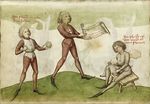 |
Caution: Scribes at Work This article is in the process of updates, expansion, or major restructuring. Please forgive any broken features or formatting errors while these changes are underway. To help avoid edit conflicts, please do not edit this page while this message is displayed. Stay tuned for the announcement of the revised content! This article was last edited by Michael Chidester (talk| contribs) at 17:11, 12 June 2020 (UTC). (Update) |
| Giacomo di Grassi | |
|---|---|
 | |
| Born | 16th century Modena, Italy |
| Died | after 1594 London, England |
| Occupation | Fencing master |
| Genres | Fencing manual |
| Language | |
| Notable work(s) | Ragione di adoprar sicuramente l'Arme (1570) |
| First printed english edition |
His True Arte of Defence (1594) |
| Concordance by | Michael Chidester |
| Translations | Český Překlad |
Giacomo di Grassi was a 16th century Italian fencing master. Little is known about the life of this master, but he seems to have been born in Modena, Italy and acquired some fame as a fencing master in his youth. He operated a fencing school in Trevino and apparently traveled around Italy observing the teachings of other schools and masters.
Ultimately di Grassi seems to have developed his own method, which he laid out in great detail in his 1570 work Ragione di adoprar sicuramente l'Arme ("Discourse on Wielding Arms with Safety"). In 1594, a new edition of his book was printed in London under the title His True Arte of Defence, translated by an admirer named Thomas Churchyard and published by an I. Iaggard.
Treatise
This presentation includes a modernized version of the 1594 English translation, which did not follow the original Italian text with exactness. We intend to replace or expand this with a translation of the Italian, when such becomes available.
Preface
Introduction
Single Rapier
Rapier and Dagger
Rapier and Cloak
Rapier and Buckler
Rapier and Square Shield
Rapier and Round Shield
Double Rapiers
Two-Handed Sword
Pole Weapons
Deceits and Falsings (all weapons again)
Temp
Physical Training
Copyright and License Summary
Additional Resources
- di Grassi, Giacomo; Saviolo, Vincentio; Silver, George. Three Elizabethan Fencing Manuals. Ed. James Louis Jackson. Scholars Facsimilies & Reprint, 1972. ISBN 978-0820111070
- di Grassi, Giacomo; Swanger, W. Jherek. The Way to Employ Arms with Certainty. Lulu.com, 2013.



